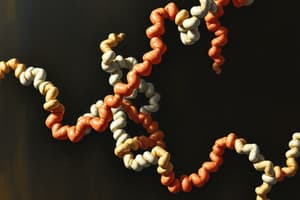Podcast
Questions and Answers
What is the time scale in which conformational changes in proteins typically occur?
What is the time scale in which conformational changes in proteins typically occur?
- 10^1 to 10^4 s
- 10^-6 to 10^-3 s
- 10^-12 to 10^-6 s
- 10^-9 to 10^3 s (correct)
What structural feature is primarily stabilized by right-handed twists in proteins?
What structural feature is primarily stabilized by right-handed twists in proteins?
- Primary structure
- Tertiary structure (correct)
- Secondary structure
- Quaternary structure
Which types of connections join adjacent antiparallel β-strands?
Which types of connections join adjacent antiparallel β-strands?
- Helices
- Loops
- Hairpins (correct)
- Crossovers
How does proline cis-trans isomerization affect protein structure?
How does proline cis-trans isomerization affect protein structure?
What is the expected distance that conformational changes can cover?
What is the expected distance that conformational changes can cover?
Which component is typically found between layers of α-helix in certain protein domains?
Which component is typically found between layers of α-helix in certain protein domains?
What kind of molecular interactions are involved in the conformational changes of proteins?
What kind of molecular interactions are involved in the conformational changes of proteins?
Which characteristic of polypeptide chains contributes to the formation of variety in tertiary structures?
Which characteristic of polypeptide chains contributes to the formation of variety in tertiary structures?
What is the effect of hydrophobic side chains in a protein structure?
What is the effect of hydrophobic side chains in a protein structure?
Which type of proteins typically play a structural role in nature?
Which type of proteins typically play a structural role in nature?
How do fibrous proteins mainly organize their structure?
How do fibrous proteins mainly organize their structure?
What structural feature is dominant in α-keratins?
What structural feature is dominant in α-keratins?
What potential problem arises in the simplicity of the folding model for proteins?
What potential problem arises in the simplicity of the folding model for proteins?
What is the role of terminal cap domains in α-keratin molecules?
What is the role of terminal cap domains in α-keratin molecules?
Which feature characterizes keratin filaments in terms of their structural composition?
Which feature characterizes keratin filaments in terms of their structural composition?
Why are hydrophobic side chains energetically costly in protein folding?
Why are hydrophobic side chains energetically costly in protein folding?
What effect does a decreased surface-to-volume ratio have on proteins?
What effect does a decreased surface-to-volume ratio have on proteins?
What is the primary function of molecular chaperones?
What is the primary function of molecular chaperones?
Why is oligomeric association considered genetically economical?
Why is oligomeric association considered genetically economical?
Which of the following statements about TIM barrels is true?
Which of the following statements about TIM barrels is true?
In the context of enzymes, what role does oligomeric association play?
In the context of enzymes, what role does oligomeric association play?
How do most oligomeric enzymes regulate their catalytic activity?
How do most oligomeric enzymes regulate their catalytic activity?
Why might proteins with similar structures not share similar functions?
Why might proteins with similar structures not share similar functions?
How many structures does the Protein Data Bank currently curate?
How many structures does the Protein Data Bank currently curate?
What characterizes positive cooperativity in multisubunit proteins?
What characterizes positive cooperativity in multisubunit proteins?
What is the outcome of negative cooperativity in proteins?
What is the outcome of negative cooperativity in proteins?
What is the role of heat shock proteins such as Hsp70?
What is the role of heat shock proteins such as Hsp70?
What does the term 'allostery' refer to in the context of protein function?
What does the term 'allostery' refer to in the context of protein function?
What is a significant characteristic of bacterial glutamine synthetase's active sites?
What is a significant characteristic of bacterial glutamine synthetase's active sites?
What characterizes the stability of secondary structures like α-helices and β-pleated sheets?
What characterizes the stability of secondary structures like α-helices and β-pleated sheets?
How many amino acid residues are typically found in one turn of an α-helix?
How many amino acid residues are typically found in one turn of an α-helix?
What direction do all hydrogen bonds in an α-helix point?
What direction do all hydrogen bonds in an α-helix point?
What is the typical average length of an α-helix in terms of number of residues?
What is the typical average length of an α-helix in terms of number of residues?
In a paralel β-pleated sheet, how do adjacent peptide chains align?
In a paralel β-pleated sheet, how do adjacent peptide chains align?
What is the characteristic distance between residues in a typical antiparallel β-pleated sheet?
What is the characteristic distance between residues in a typical antiparallel β-pleated sheet?
Which of the following statements accurately describes the arrangement of hydrogen bonds in a β-pleated sheet?
Which of the following statements accurately describes the arrangement of hydrogen bonds in a β-pleated sheet?
What type of structure provides both flexibility and strength in spider silk?
What type of structure provides both flexibility and strength in spider silk?
How do nonpolar residues located near the termini of an α-helix typically behave?
How do nonpolar residues located near the termini of an α-helix typically behave?
What is a defining feature of parallel β-pleated sheets compared to antiparallel ones?
What is a defining feature of parallel β-pleated sheets compared to antiparallel ones?
What effect does the shearing force have on keratin protein during silk extrusion from a spider's glands?
What effect does the shearing force have on keratin protein during silk extrusion from a spider's glands?
What is the pitch of an α-helix, given it is made of 3.6 residues per turn?
What is the pitch of an α-helix, given it is made of 3.6 residues per turn?
Which of the following statements correctly describes the H bonding pattern in an α-helix?
Which of the following statements correctly describes the H bonding pattern in an α-helix?
Flashcards are hidden until you start studying
Study Notes
Secondary Structure of Proteins
- Secondary structure refers to local conformations of polypeptides stabilized by hydrogen bonds.
- Hydrogen bonds form between the amide proton of one peptide group and the carbonyl oxygen of another.
- Common secondary structures include α-helices and β-pleated sheets.
α-Helix Structure
- One turn of the helix consists of 3.6 amino acid residues.
- Each amino acid residue contributes 1.5 Å (0.15 nm) along the helix axis with a total pitch of 5.4 Å (0.54 nm).
- Average length of an α-helix is typically 10 residues, but this can vary.
- Each carbonyl in the helix forms an H bond with the N-H group of a residue located four residues upstream.
- H bonds are oriented parallel to the helix axis, creating a significant dipole moment.
- Charged ligands (e.g., phosphates) often bind to the positively charged N-terminus of the α-helix.
β-Pleated Sheet Structure
- Visualized as pleated strips or zigzag patterns formed by peptide strands.
- Parallel β-sheets have adjacent chains running in the same direction with a spacing of 0.325 nm.
- Antiparallel β-sheets consist of chains running in opposite directions with a distance of 0.347 nm.
- β-sheets require an alternating arrangement of hydrophilic and hydrophobic residues.
- Side chains extend out perpendicularly from the pleated sheet structure.
Spider Silk Composition
- Spider silk is a keratin with exceptional tensile strength, 200,000 psi, surpassing steel.
- Silk's strength and flexibility arise from its composite structure of keratin.
- Keratin is extruded from spider glands, initially holding H bonds in α-helices, which transform into β-sheet microcrystals upon stress.
- The unique structure of silk parallels engineered composite materials.
Protein Folding and Structure Types
- Proteins can be categorized into fibrous, globular, and membrane proteins.
- Fibrous proteins have parallel chains and are mechanically strong, often serving structural roles (e.g., keratins in hair and nails).
- α-keratins are primarily composed of α-helical segments, forming coiled coils that aggregate into layered structures.
Oligomeric Proteins and Function
- Oligomeric association allows proteins to be genetically economical, requiring less DNA for coding.
- Monomeric proteins like HIV protease derive function from subunit interactions.
- Cooperative binding is evident when ligand binding at one site alters the affinity at other sites, indicating allosteric influence.
Conformational Changes
- Structural shifts in proteins can occur on nanosecond to microsecond timescales, driven by environmental stimuli or internal interactions.
- Proline residues can undergo cis-trans isomerization, functioning as regulatory switches within proteins.
Importance of Protein Domains
- Proteins adopt complex tertiary structures, exhibiting right-handed twists that enhance stability.
- A common structural motif is the TIM barrel, featuring alternating α-helices and β-strands forming a barrel-like structure.
- Similar structures may perform distinct functions, indicating that the relationship between structure and function is not always straightforward.
Molecular Chaperones
- Molecular chaperones are vital for correct protein folding and preventing undesired interactions during synthesis and transport.
- Heat shock proteins (Hsp) are induced in response to stress and assist in protein assembly.
- Hsp70 and chaperonins (Cpn60s or Hsp60s), such as GroEL, are critical classes of chaperones facilitating protein folding.
Studying That Suits You
Use AI to generate personalized quizzes and flashcards to suit your learning preferences.





